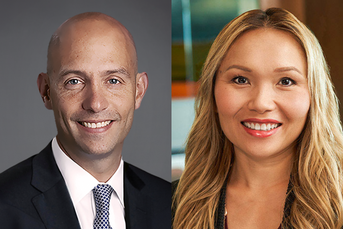The last-minute IRA dash before Tax Day is real
 Alex Ammar of Paradox Financial and Rita Assaf of Fidelity
Alex Ammar of Paradox Financial and Rita Assaf of Fidelity
Contributions to IRAs are up significantly this season for the 2023 tax year, according to Fidelity.
More people are putting money into an IRA just ahead of the April 15 deadline for filing federal taxes, as market conditions have made them optimistic compared with 2022, data from Fidelity show.
It’s normal for the majority of contributions to individual retirement accounts to happen between the beginning of the year and April 15, but this year such contributions increased by 28 percent over those that were made ahead of the deadline in 2023 for the 2022 tax year.
“We’re definitely seeing more activity this year. We think it’s from the market buoying this,” said Rita Assaf, vice president of retirement products at Fidelity. “This year, more optimism has come in, and there have been some market highs.” Inflation concerns were also higher a year ago, which was partially responsible for the lower level of contributions for the 2022 tax year, Assaf said.
Most of the IRA contributions in a given year, especially on the Roth side, tend to happen during tax season, as people have a better idea of their net income and whether they qualify for Roth contributions, she said. It’s also common to use tax refunds to make contributions, she noted.
“It ebbs and flows during tax season. You’ll see it generally come in strong in the beginning, and then there’s this mad dash in the last two weeks” before April 15, Assaf said.
Over the past few weeks, IRA contributions have been up by 40 percent compared with the beginning of the year, the Fidelity data show. The number of accounts receiving contributions is up by 31 percent compared with a year ago, with a lot of that coming from younger generations. While millennials have bumped up their IRA contributions by 35 percent, Gen Z made a big move, with their numbers up by 83 percent. That’s partly because an increasing number of members of Gen Z are in the workforce, Assaf said.
“They’re also more engaged, from the research we’ve seen,” she said. Compared with older generations, Gen Zers are more likely to have accounts and appear more interested in allocating assets on their own.
Across all generations, the average total IRA contribution for 2023 is about $1,300, according to Fidelity. Among people younger than 50, 22 percent contributed the maximum of $6,500, while 38 percent of those over 50 did so, including the additional catch-up contributions of $1,000.
“We have been squeezing in IRA contributions just before the April 15 deadline. We typically like to complete them after year-end, when we know their final annual income,” Noah Damsky, principal at Marina Wealth Advisors, said in an email. “This way, there are the fewest mistakes, which can be a pain or costly to sort out.”
Another advisor, Alex Ammar, owner of Paradox Financial, said he’s seen an increase among clients making IRA contributions this year for 2023.
“I’ve also been proactively bringing it up in conversations with people I haven’t worked with before,” Ammar said in an email. “I’m happy to see this increase, and I’m hopeful that it points to an increase in awareness and public education.”
But last minute is not always a great strategy, said Daniel Masuda Lehrman, owner of Masuda Lehrman Wealth.
“For many of my clients that procrastinate on doing things they dread, like preparing and filing their taxes, making last-minute IRA contributions to reduce taxable income is definitely a common occurrence,” Masuda Lerhman said in an email. “I reach out to my clients far before the April 15th deadline to let them know [about the tax deductibility of contributions]. In fact, the best time to remind clients to make IRA contributions is right after they’ve filed their taxes, especially if they recently had to pay a hefty tax bill.”
Setting up automatic IRA contributions is a good way to avoid the last-minute headache, Assaf said. It’s also important to tell account owners that unlike many 401(k)s, IRAs don’t have a default investment that contributions automatically go to.
“Make sure you’re invested, and make sure you’re invested according to your risk and time horizon,” she said. “Tax season is usually a good time to revisit that, because you’re bringing money in.”
High-quality bonds a bargain compared to stocks, says Schroders portfolio manager
Learn more about reprints and licensing for this article.








